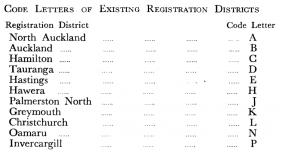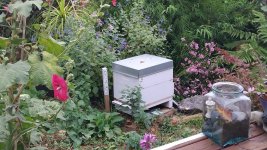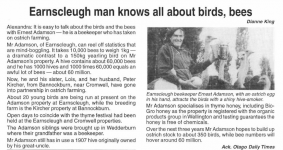NZ has had some form of required apiary registration system since 1928...
Back then, the required information related to the number of Italian bees, Black bees and Cross-bred bees that the beekeeper owned.
The register was held centrally, in the Wellington office of the Dept of Agriculture. Regulations in 1937 gave specific power to keep the records "bookwise" or in "card form", and were allowed to be rearranged to any chosen order!
It wasn't until 1953 that the apiary registers were 'devolved' to the Dept Ag offices and the apiary instructors. But still, for a beekeeper, there would have been no feeling of having a code number assigned to them, though each apiary district began to do so, at least for internal purposes.
1958 brought the numbering system pretty much as we have it now. Each of the apiary districts was assigned a letter to precede the number.

I'm not sure how close to that the allocations are now. There may be a few additional districts/letters?
Another new provision in 1958 would be that beekeepers needed to clearly display their apiary number in each bee yard, either painted on a box, or using a 2"x2" wooden stake.
So when I registered as a beekeeper in 1978, having bought some hives outside Rotorua, I registered with the Tauranga MAF office - Doug Briscoe was in his last few years in the apiary section. And he assigned me the number D0482.
And it has remained my number ever since, even through a prolonged period of not having any hives.
In 1983 I was writing a distance education beekeeping programme at the Bay of Plenty Community College and registered hives for the BOPCC. They got number D0806. So from 1978 to 1983 - 15 years - the Tauranga office had a total of 350 new beekeepers. But that doesn't tell you about any that have left in the meantime, though.
There have always been a few registration numbers that stick in my mind, ones that I might see around neighbouring beekeepers in the past. But I think I generally recognise their hives more by colour, condition and layout, rather than actually seeing the number displayed.
The current capabilities of the HiveHub system certainly show the opportunities afforded by modern technological capabilities. I look forward to its on-going and further development. It has D0482 as an active beekeeper again now...
Back then, the required information related to the number of Italian bees, Black bees and Cross-bred bees that the beekeeper owned.
The register was held centrally, in the Wellington office of the Dept of Agriculture. Regulations in 1937 gave specific power to keep the records "bookwise" or in "card form", and were allowed to be rearranged to any chosen order!
It wasn't until 1953 that the apiary registers were 'devolved' to the Dept Ag offices and the apiary instructors. But still, for a beekeeper, there would have been no feeling of having a code number assigned to them, though each apiary district began to do so, at least for internal purposes.
1958 brought the numbering system pretty much as we have it now. Each of the apiary districts was assigned a letter to precede the number.

I'm not sure how close to that the allocations are now. There may be a few additional districts/letters?
Another new provision in 1958 would be that beekeepers needed to clearly display their apiary number in each bee yard, either painted on a box, or using a 2"x2" wooden stake.
So when I registered as a beekeeper in 1978, having bought some hives outside Rotorua, I registered with the Tauranga MAF office - Doug Briscoe was in his last few years in the apiary section. And he assigned me the number D0482.
And it has remained my number ever since, even through a prolonged period of not having any hives.
In 1983 I was writing a distance education beekeeping programme at the Bay of Plenty Community College and registered hives for the BOPCC. They got number D0806. So from 1978 to 1983 - 15 years - the Tauranga office had a total of 350 new beekeepers. But that doesn't tell you about any that have left in the meantime, though.
There have always been a few registration numbers that stick in my mind, ones that I might see around neighbouring beekeepers in the past. But I think I generally recognise their hives more by colour, condition and layout, rather than actually seeing the number displayed.
The current capabilities of the HiveHub system certainly show the opportunities afforded by modern technological capabilities. I look forward to its on-going and further development. It has D0482 as an active beekeeper again now...




